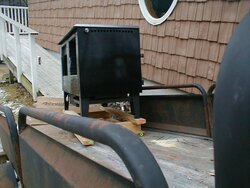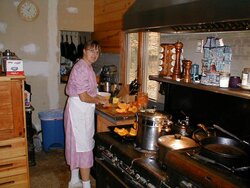I'm wondering if a Kitchen Queen wood cookstove- (very large fire box for a cookstove) with the water heating coils in the firebox would be able to supply enough heat for radiant heat. The literature says that it heats 40 gallons an hour. I know we would need a large water storage tank with some kind of heat exchanger.
Greetings MagicEarth, I stumbled over this post and thought I should comment. I don't want to steal my friends at Antique Stoves glory, Ed is a great guy, knows a lot about Antique Wood Cook Stoves.
The Amish, enough said, I lived amongst them for a while as well. I found that living among the mountain folks in Montana made more sense for this family, they are far more straight forward and you know where you stand with them, they understand "sustainability" as well.
With the Amish I have found that your always an outsider if your "English".
The marketing of "Amish", for Craftsmanship is something to be written about in Sales and Marketing text books in schools everywhere, In reality, they put their pants on one leg at a time just like us, with lots of baggage too.
One of our competition in West Virginia touts themselves as "Plain Folk" yet runs an eCommerce company selling cookstoves and whatever else they can peddle to the ignorant city slickers who think, 'because they look Amish.....they must be honest and can teach me to be self sufficient". They see no Irony in any of it........as they hand over their cash.
Enough of that Bunny Trail,
I am asked this question everyday during "Stove Season". "Can I also heat my radiant floor with my Kitchen Queen?"
For me there are two seasons, the other one is "Wildfire Season", yes I'll admit it, I'm a Pyromaniac. Fire is a BIG part of my life.
A wood fired boiler is specifically designed to do what it does safely, it carries safety certificates and testing validation that it won't explode and kill you and your family.
If it does you can call your attorney.
A Kitchen Queen Water Coil is designed to heat the water reservoir on the back of the stove that is a open non pressurized system and can not build pressure. It can not explode.
Can a Kitchen Queen act as a hot water boiler? Yes, but why, the Kitchen Queen throw over 100,000 BTUs of useful convection heating, it should more than heat your space.
But being a Radiant Floor lover myself, I can understand warm feet make all the difference, I have helped many folks heat other parts of their home that could not be heated conventionally with convection hot air, using their wood cookstoves. In all cases I worked with them and grew comfortable with their abilities, because of the liability involved few dealers will help, or feel comfortable enough understanding hydronic systems to comment. As an Firefighter Engineer, I take safety very seriously which is why I made so many YouTube videos on this subject with many more to come.
https://www.youtube.com/user/WoodyChain
https://www.youtube.com/user/wildfirefighters
I have sold over a thousand Kitchen Queens and they are one of my favorite stoves because of the reviews they generate and referral customers, they sell themselves.
I also like the ESSE Ironheart and because there is instructions printed in the owners manual on how to hook up a radiant hot water heating system I will share with you some pictures of one of my favorite craftsmen customers from California.
The first picture is of the Obadiah's Water Stove we designed that could heat domestic hot water and the radiant water in our floors. This picture is in our home and we used this system for a couple years to heat our home and hot water for bathing.
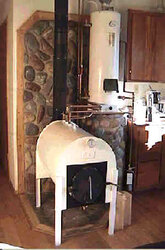
Below is a properly designed and installed radiant/
domestic hot water system installed on a ESSE Ironheart.
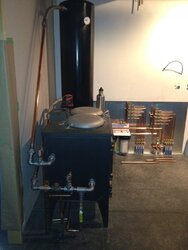
Below is a diagram off page 8 and 9 of the ESSE Ironheart EWB Boiler installation.


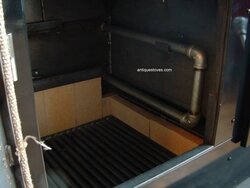
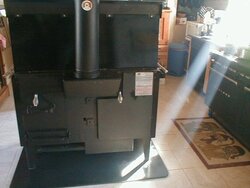
 T across the floor.
T across the floor. , then we need to flow 23,000 / 20 = 1150 pounds/hour. At 8 pound of water / gallon 1150/8 = 144 gallons/hour. Which equals 2.4 gallons per minute to heat our house if the water passing through the floor loses 20
, then we need to flow 23,000 / 20 = 1150 pounds/hour. At 8 pound of water / gallon 1150/8 = 144 gallons/hour. Which equals 2.4 gallons per minute to heat our house if the water passing through the floor loses 20